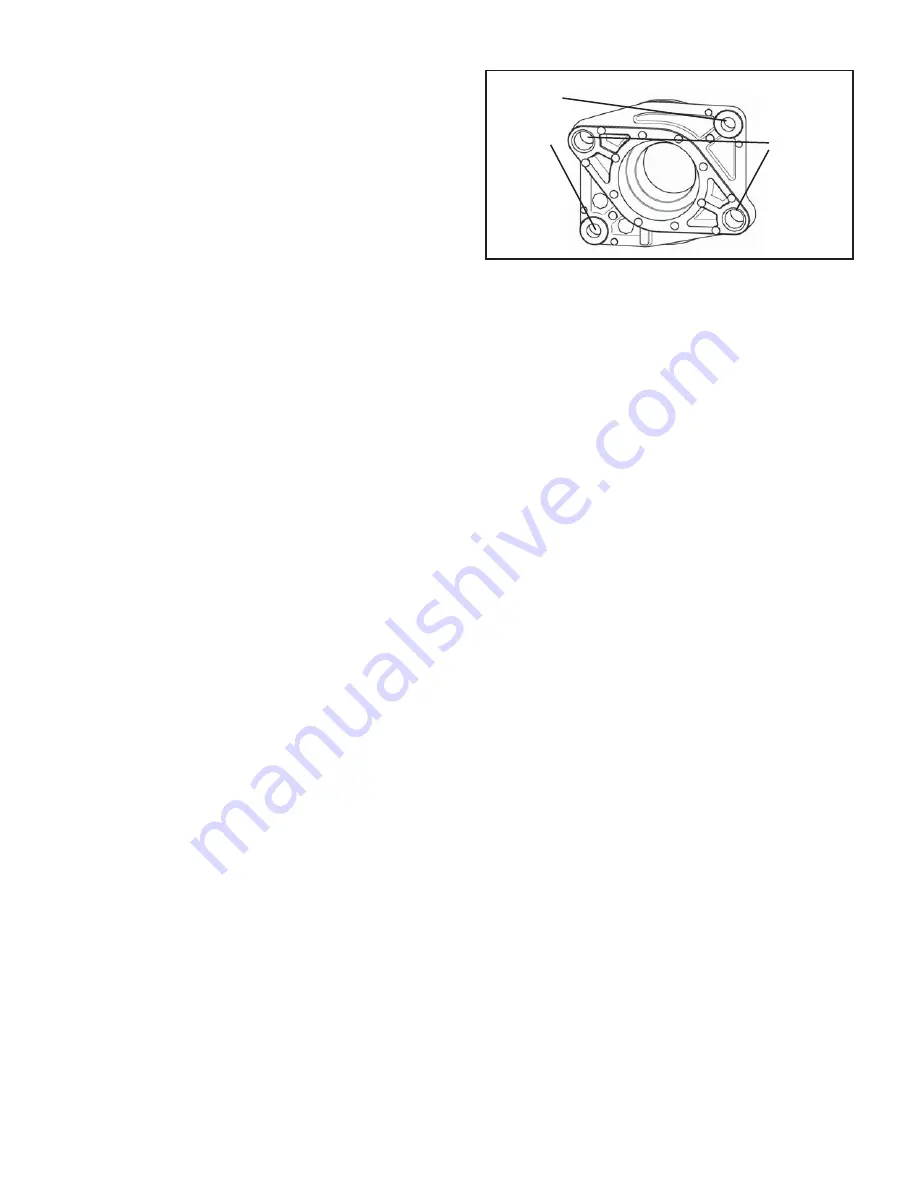
9
6. Gently tap the cylinder head (15), cooling plate (14) and
valve plate assembly (13) with a soft mallet to break
the gasket seals. Then separate the cylinder head (15)
from the cooling plate (14) and valve plate assembly
(13), and remove and discard the two head gaskets (4)
between them.
CRANKCASE FRONT COVER
1. Remove the cover (10) from the front of the crankcase.
Use a sharp fl at head screw driver or a scraper. Place
the edge under the lip along the outside diameter of
the cover. Pry the cover from the cast surface until the
cover can be removed.
REAR END COVER
1. Note: There are two cap screws (7) used to retain the
end cover to the crankcase. There are two longer cap
screws (not shown in Figure 9) that are used to retain
the auxiliary drive unit (i.e. hydraulic pump) via the end
cover and torqued into the crankcase. If the auxiliary
drive unit has already been removed, these two cap
screws are no longer present on the end cover.
Refer
to Figure 9 to see location of the cap screws (7) in the
end cover.
2. Remove the two end cover cap screws (7) that secure
the rear end cover to the crankcase.
3. Remove the rear end cover (8) from the crankcase.
Remove and discard the o-ring (9) from the end cover
(8).
CLEANING OF PARTS
GENERAL
All parts should be cleaned in a good commercial grade of
solvent and dried prior to inspection.
CRANKCASE
1. Carefully remove all sealant gasket material adhering
to the machined face of the crankcase.
See Figure
3.
Make certain not to scratch or mar the mounting
surface. Note: Keep the crankcase (11) opening
covered to prevent any of the sealant material from
entering. Repeat this process on the engine mounting
face as well. Follow the instructions contained in the
vehicle maintenance manual in lieu of the instructions
and procedures presented in this manual.
2. Carefully remove all gasket material adhering to the
deck (top) of the crankcase. Remove any carbon
deposits from the deck of the crankcase. Make certain
not to scratch or mar the gasket surfaces.
CYLINDER HEAD, COOLING PLATE & VALVE
PLATE ASSEMBLY
1. Carefully remove all gasket material adhering to the
cylinder head (15), cooling plate (14) and valve plate
assembly (13). Make certain not to scratch or mar the
gasket surfaces. Pay particular attention to the gasket
surfaces of the cylinder head and cooling plate.
2. Remove carbon deposits from the discharge and inlet
cavities of the cylinder head, cooling plate and valve
plate assembly. The cavities must be open and clear.
Make certain not to damage the parts,while cleaning.
3. Remove rust and scale from the cooling cavities and
passages in the cylinder head, cooling plate and valve
plate assembly and use shop air to clear debris from
the passages.
4. Check the threads in all cylinder head ports for
galling (e.g. abrasion, chafi ng). Minor thread chasing
(damage) is permitted.
INSPECTION OF PARTS
CYLINDER HEAD, COOLING PLATE AND VALVE
PLATE ASSEMBLY
1. Carefully inspect the head gasket surfaces on the
cylinder head (15) for deep gouges and nicks. Also,
inspect the cylinder head for any cracks or port thread
damage. If detected, the compressor must be replaced.
If large amounts of carbon build-up are present in the
discharge cavity such that it restricts the air fl ow through
the cylinder head, the compressor should be replaced.
2. Carefully inspect both sides of the head gasket surfaces
on the cooling plate (14) for deep gouges and nicks.
Also, inspect the cooling plate for any cracks or other
damage. If damage is found, the compressor must be
replaced.
3. Carefully inspect the valve plate assembly (13) gasket
surfaces (both sides) for deep gouges and nicks. Pay
particular attention to the gasket surface. An inlet
reed valve/gasket (5) is used between the valve plate
assembly (13) and crankcase. These gasket surfaces
must be smooth and free of all but the most minor
scratches. If excessive marring or gouging is detected,
FIGURE 9 - REAR END COVER ATTACHMENT BOLTS
M10x1.5
Cap
Screws
(Larger)
M8x1.25
Cap
Screws
(Smaller)
Содержание 360CC
Страница 12: ...12 Notes...










































